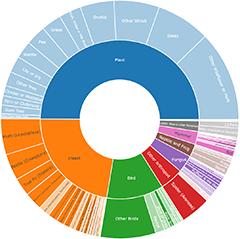Noctuoid moths (except Arctiinae)
This moth sub-category for the superfamily Noctuoidea contains the large families Noctuidae and Erebidae as well the smaller Euteliidae, Nolidae, Notodontidae and Oenosandridae. The Arctiinae also belong to this superfamily, but are distinctive and well known so are given their own moth sub-category
Announcements
There are currently no announcements.
Discussion
ibaird
wrote:
Yesterday
After an extensive search online I could not find a match for this moth. I suspect targeting the 'Piliga Scrub' would yield interesting results.
Proteuxoa (genus)
donhe
wrote:
23 Sep 2025
Praxis have a smoothly curved forewing submarginal dark line, whereas Eudesmeola has a wavy line.
Eudesmeola lawsoni
ibaird
wrote:
23 Sep 2025
I notice iNatutalist has introdiced the synomym 'Androdes' (AFD) for some species fore\merly known as Proteuxoa (genus).
Proteuxoa (genus)
ibaird
wrote:
23 Sep 2025
Yes, the apperent diversity of Proteuxoa (genus) never ceases to amaze me! I hsvr not seen this distinctive moth before.
Proteuxoa (genus)
Significant sightings
- Proteuxoa sp. (03) (MoV, Part 9) at Harrison, ACT
- Hymeninae sp, (2) (MoV) at Bulli, NSW
- Nola tornotis at Bulli, NSW
- Earias smaragdina at Rosedale, NSW
- Pherechoa crypsichlora at Melba, ACT
- Spodoptera mauritia at Bargo, NSW
- Hypeninae sp. (3) (MoV Part8) (Erebidae (Hypeninae))
- Paromphale caeca (Acronictinae) at Jerrabomberra, NSW
- Proteuxoa sp. (17) (MoV, Part 9) at Tathra, NSW
- Agrotis infusa at Googong, NSW
Top contributors
- kasiaaus 864
- jb2602 830
- PJH123 693
- WendyEM 381
- AlisonMilton 339
- SteveBorkowskis 250
- Bron 235
- ibaird 223
- JohnBundock 189
- Hejor1 187
Top moderators
- donhe 3.2K
- ibaird 3K
- GlennCocking 535
- DianneClarke 329
- WendyEM 295
- MichaelMulvaney 180
- MichaelBedingfield 65
- JulieMorgan 41
- KimPullen 31
- jb2602 25






















































































